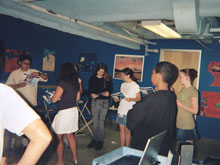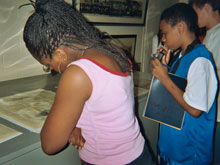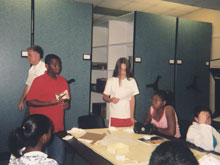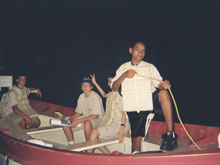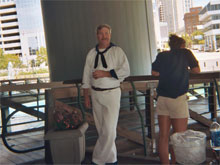
Left to right: Emily, Jennifer, David, Marcus, Jacob, Joseph, Jazmine, and Tracy pose for the camera on the portico at the Hampton Roads Naval Museum. Click image for larger view and image credit.
Krista Trono from National Marine Sanctuaries mediates a round table discussion on current issues, while Derrick, Emily, Jenny, Miranda, and Brandon read up on the sanctuaries. Click image for larger view and image credit.
Cumberland Club 2007
Students participating in the 2007 Cumberland Club project, which ran from June 18 to 29, kept daily journals reflecting their thoughts and describing what they learned. What follows are journal entries written by the students as well as some of their images.
DAY 1
Morgan
Blair Middle
June 18, 2007
During the summer, I participated in a camp called the Cumberland Club. It has been a lot of fun. I learned about the underwater archeology of the USS Cumberland. The Cumberland is a frigate, a fast war ship with three masts. The Cumberland was first put into water in 1842. She has been in the Mediterranean Sea three different times. John Dahlgren invented several different types of cannons and perfected the rifled cannon barrel. He served aboard the USS Cumberland.
One hundred and forty-five years ago the Earth shattered in change. Iron versus iron, the results of this battle would forever revolutionize naval warfare. The Merrimack is owned by the Union. On April 21, 1861, after the Confederate attack on Fort Sumter, Union troops burned and evacuated Gosport Shipyard to prevent the Confederates from seizing the U.S. Navy supplies and ships. Ships of Delaware and Pennsylvania were destroyed by flames.
Jake
Lynnhaven
June 18, 2007
Today we were introduced to everything we were going to do in this camp. Then we walked over to a site. It was called Half-Moon, because that was the name of the Dutch fort that was there before the English came in the 1600s. We mapped the site using a grid system. We drew a site plan, and used flags to mark surface finds. Next we learned about the history of the USS Cumberland. It was a frigate and it turned into a sloop of war in 1857. It had Dahlgren cannons that looked like bottles.
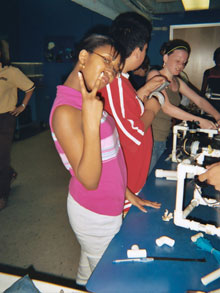
The Cumberland Club members are constructing their ROVs. Meghab gives us the peace sign as her team mates Derrick and Morgan are hard at work. Click image for larger view and image credit.
DAY 2
Kevaundra
Rosemont
June 19, 2007
The conservation of iron objects has five main methods. The conservation techniques considered are: electrochemical, alkaline sulfite, chemical cleaning, water diffusion in an alkaline solution, and annealing. Annealing is to make metals less brittle by heating it. Iron corrodes when you have iron, water, and oxygen. Together these things cause rust. This process can be accelerated with salt added to the water. We did experiments in the NOAA classroom to test corrosion.
We learned about multibeam sonar and shipwrecks in the NOAA classroom. Matt and Becky (Hampton Roads Naval Museum interns) showed us a shipwreck (which was fabricated for the lesson). We used the multibeam information to create a 3-D map of the shipwreck. The Captain’s diary was found. The Captain wrote that there was a bad storm, and disease which may have been the cause of the wreck.
Jazmine
Lafayette – Winona
June 19, 2007
We learned about five categories of conservation of iron:
- Electro chemical
- Alkaline sulfite
- Chemical cleaning
- Annealing
- Water diffusion
Spotting corrosion on the battleship:
We went out onto the USS Wisconsin to look for signs of rust. None was noticeable except on the screws and nails.
Bathymetry:
- Make a clay model of the USS Dominion (fake) using multibeam sonar to uncover it.
- Side scan sonar — two dimensional image
- Multibeam sonar — color represents depth
DAY 3
Brandon
Rosemont Middle
June 20, 2007
Today we went down to the Norfolk Naval Station, to a top secret artifact storage facility. We saw artifacts from the Cumberland, old Navy uniforms, and other stuff that was used in the Navy a long time ago. We also got to see and touch the artifacts while wearing rubber or cotton gloves. Nearly all the things we saw had not been seen by most people. Even the museum’s director had not seen a lot of these artifacts. Plus we got to see commissions signed by Presidents of the United States.
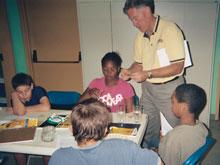
Marcus, Nicole, Brandon, and Jacob learn about corrosion first hand as Odean conducts experiments with iron nails. Click image for larger view and image credit.
Nicole, Brandon, and Joseph examine historic documents in the Hampton Roads Naval Museum artifact storage facility, located at the Naval Station Norfolk. Click image for larger view and image credit.
David
Lynnhaven Middle
June 20, 2007
Today Cameron and I made an amazing discovery. We were looking at an artifact and had no idea what it was. It was just two pieces of wood put together by three rivets. One of the rivet's tops was fancy and had words on it. Cameron looked at it and thought it was a cross, but when I looked at it, it was the justice scales! It was an amazing discovery! We still don’t know what it is, but we are going to send it off to be conserved and maybe someone will find out what it is.
Joseph
Azalea Garden Middle
June 20, 2007
Today we were able to handle artifacts not yet seen by the general public. We analyzed some of the USS Cumberland artifacts and chose two to be sent off and preserved. Yesterday we built ROVs (remotely operated vehicles). They were simple vehicles built out of PVC piping and fish tank motors. This camp is fun and I wish I could come back every year.
Alajuwon
Lafayette – Winona
June 20, 2007
Today we went to the Naval Station Norfolk to look at the Hampton Roads Naval Museum’s artifact storage area. We looked at artifacts from the Cumberland and even handled some of them. After we looked at the artifacts, we ate lunch at McClure baseball field on the base. It was built in 1917, and is the oldest brick baseball stadium in America! Then we went to Mr. Taylor’s office and got to observe, record, and work on some of the artifacts. After that we decided which two artifacts to help conserve. We picked the back plate of one of the Dahlgren guns and a small round object with a brass round item with a justice mark on it. The justice symbol was found by my friends David Hart and Cameron Parsons. We took pictures of our artifacts and filled out all their information for the museum’s records.
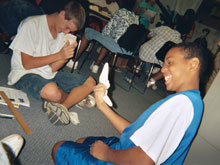
Joseph and Brandon laugh as they analyze artifacts from the USS Cumberland at the Naval Station Norfolk artifact storage facility. Click image for larger view and image credit.
At the artifact storage facility inside Naval Station Norfolk, Tracey, Jazmine, Darius, Marena, Nicole, Morgan, and Derrick present their findings to the rest of the group. Click image for larger view and image credit.
Marena
Lynnhaven Middle
June 20, 2007
Today we went to the Naval Station Norfolk. We got to handle artifacts from the USS Cumberland. These artifacts included part of a cannon, cannon balls, parts of shoes, cloth materials, a key, and other artifacts. It was our first step to actual archeology. It was awesome!!! This trip has really encouraged me even more to fulfill my dream of becoming and archeologist.
Derrick
Rosemont
June 20, 2007
The Cumberland Club is a fun-packed and interesting program. In my recent days here I have learned so much, and had lots of fun. On my first day we basically had an introduction to the rest of the week. The second day we sculpted a fake shipwreck using multibeam sonar data. Today we went to the Naval Station to learn about artifacts from the Cumberland. It was fun.
DAY 4
Darius
Azalea Gardens
June 21, 2007
For today’s adventure, we took a trip to the Mariners' Museum in Newport News. We looked at many artifacts and saw a movie about the sinking of the Monitor. The red signal lantern was the last thing seen on the sinking vessel, and the first thing found by underwater archeologists. We saw a recreation of the CSS Virginia and more artifacts. We saw another movie about the CSS Virginia versus the USS Monitor, iron versus iron. It was a good battle between the ships. Then we learned more about the Monitor, and walked on a recreation of the ship. We saw several models of the Monitor’s turret: one was right side up, and the others were flipped upside down, because that is how the turret landed on the ocean floor. Best of all we got to see the actual turret, flipped upside down from the waves years ago, which was really cool. Then we got to see the artifacts being conserved in the conservation laboratories. We learned about freeze drying and electrolysis. This tour was a learning experience, and I am very happy to have participated.
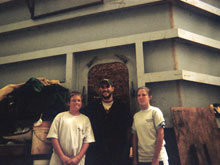
Jacob and Marena pose with one of the conservators who was working on the Monitor’s turret. Click image for larger view and image credit.
Brandon, David, Cameron, and Joseph pose inside a reproduction of a Titanic life boat at the Mariners' Museum. Click image for larger view and image credit.
Meghan
Blair Middle
June 21, 2007
Today the club went to the Mariners' Museum to learn about the battle of the Merrimack versus the Monitor, North versus South, and Iron versus Iron. I learned how they battled for over four hours, and then they tried to ram each other. The Merrimack (CSS Virginia) destroyed three other Union ships — the Minnesota, the Congress, and the famous Cumberland. There was a draw after the battle, but both ships met their fates later on.
DAY 5
Jenny
Lafayette – Winona
June 22, 2007
We went on the sailing ship, the American Rover, and sailed around the harbor. We saw a lot of other ships used for transporting goods and soldiers to and from places. We learned from Mr. Mordicca (Civil War Sailor Re-enactor) that sailors used a lot of rope tricks and had to know how to splice and tie knots onboard a ship. He taught us a lot of songs that sailors would sing when they were working. A lot of the songs helped with the work because everyone would have the same rhythm when they sang. A boy could join the Navy when he was ten years old and get paid $13 a month. I also learned that there are a lot of people that steal artifacts from wreck sites like the Cumberland and sell the artifacts to people for thousands of dollars!
Marcus
Lynnhaven
June 22, 2007
Today we got to learn some knots like the figure 8, monkey’s fist, square knot, and reef knot. Then we learned things about sailing from a guy dressed like a civil war sailor. After our lessons we got aboard the American Rover and sailed on it. We had a pizza party back at the museum. We learned about the history of the other wreck near the Cumberland. It was the CSS Florida. It helped stop the slave trade, and was once a British ship.
Cameron, David, and Marena point to the bust at the Mariners' Museum. (Note: no statues were harmed in the making of this photo.) Click image for larger view and image credit.
A Civil War sailor reenactor, Alan Mordicca poses after returning from a voyage aboard the sailing vessel American Rover. Intern Lindsey peers into the water. The students learned about knot tying and life aboard a Civil War Navy ship from the reenactor. Click image for larger view and image credit.
DAY 9
Jewel
Rosemont
June 26, 2007
Today we sailed on the NOAA boat Bay Hydrographer. We got to see the wrecks of the Florida and the Cumberland. It was a great experience for the whole group. We got to see how real sonar works. I was amazed at all of the technology that was used on the ship, especially the multibeam data. “V” let us use the remote to raise and lower the side scan sonar while it was in the water. It had to stay at a depth of 8 meters.
DAY 10
Miranda
Blair
June 27, 2007
Today we went on the NOAA ship, Bay Hydrographer. We went to see the wreck through side scan and multibeam sonar images. There is a lot of equipment used by the NOAA people to get the images and see how far down a ship is, and how much debris and mud and silt have covered it up. The side scan sonar was called a "fish," and we lowered it into the water with a big cable attached to it. It only scans one way and gives us a black and white image. The multibeam sonar is attached to the ship and is really big. It gives us colorful images of the shipwreck. My experience in the Cumberland Club was a very fun one. To go and do all these things that you would have to wait to do is very cool. In just one week every thing we did was exhilarating. I really thank the people of NOAA and the Hampton Roads Naval Museum.
DAY 11
Nicole
Rosemont
June 28, 2007
Today we put the SS Towfish (side scan sonar) in the water. At 14:47 GMT, Skipper Mike and I discovered two stingrays in the water. We saw the wreck of the CSS Florida and the USS Cumberland on the side scan sonar. I got to drive the boat and see the Klein 5000 multibeam scanner: SeaBat 7125 get put into the water. The Bay Hydrographer has a draft of six feet. A long time ago people used to navigate using the stars and something called a sextant. The Bay Hydrographer keeps slowing down when another boat approaches. The side scan sonar picked up some things that looked funny and were not supposed to be there. “V” says what we see are schools of fish. If someone falls overboard, you need to yell “Man overboard!” really loud until someone responds. You should also never take your eyes off the person and always point to them. On the boat we had an issue with the electric power. We had none. So we had to turn around and go home early. I asked “V” if the ship had ever hit anything. He said, “Not this boat,” but he had hit things on a different boat.
DAY 12

Aboard the NOAA vessel Bay Hydrographer, Emily, Tracey, Cameron, and Brooks prepare to help lift the multibeam sonar out of the water. Click image for larger view and image credit.
Alajuwon and a NOAA researcher share a laugh inside the cabin of the Bay Hydrographer. Click image for larger view and image credit.
Emily
Azalea Gardens Middle
June 29, 2007
Today I had fun. We explored the wreck site of the USS Cumberland. I also had a chance to drive the boat. We used the side scan and multibeam sonars. And, for once, everyone ate their sandwiches. We cleaned off the sonar and Tracy got us all wet when she sprayed us with the hose! It was ok, I still had fun. We originally thought we were going to look for the CSS Virginia because the boat was getting fixed early in the morning and we were running behind in time. We took a vote to see who wanted to look for the Virginia and who still wanted to go out to the Cumberland. We voted 4 to 1 to go look for the CSS Virginia, but “Dictator Mike” came up and said we were going to the Cumberland. On the way up to the Cumberland we saw dolphins.
Tracey
Azalea Gardens
June 29, 2007
Today was really fun. We got on the boat and learned the safety rules. We looked at the data of the multibeam sonar. We helped take the side scan sonar out of the water. The whole camp — last week and today — was the best! Monday we learned about the National Marine Sanctuaries. Tuesday we made ROVs and did a competition. Then we made clay models of sonar data and did experiments on corrosion. On Wednesday we went to the Norfolk Naval Station and saw artifacts from the Cumberland. Thursday we went to the Mariners' Museum. We saw the turret of the Monitor and other artifacts. On Friday we learned how to tie knots and went out on the American Rover. Today we saw dolphins and helped the NOAA researchers collect new data. All together I had the best time.
Emily shows off her knot-tying skills aboard the Bay Hydrographer. Click image for larger view and image credit.
Cameron
Lynnhaven
June 29, 2007
Today was a lot of fun. We arrived at NOAA and were going to search for the CSS Virginia, but Mr. Taylor wouldn’t allow us to. After a quick visit to the “head” (bathroom) we were underway. So we boarded the boat. Skipper Mike allowed me to actually drive the boat! It was a lot of fun, even though it was on auto-pilot. We launched the side scan sonar and passed over the wreck of the Cumberland and the Florida several times while surveying the area. We then deployed the multibeam sonar. We passed over the wrecks again, and this time saw them in 3-D. It was very interesting and cool. I wish I could do it again, it was so much fun. I would like to become a ship’s Captain one day. It would be a great job and I would get to see the world.




